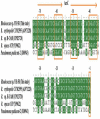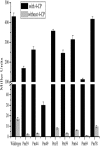4-Chlorophenol Oxidation Depends on the Activation of an AraC-Type Transcriptional Regulator, CphR, in Rhodococcus sp. Strain YH-5B
- PMID: 30405555
- PMCID: PMC6205950
- DOI: 10.3389/fmicb.2018.02481
4-Chlorophenol Oxidation Depends on the Activation of an AraC-Type Transcriptional Regulator, CphR, in Rhodococcus sp. Strain YH-5B
Abstract
4-Chlorophenol (4-CP) oxidation plays an essential role in the detoxification of 4-CP. However, oxidative regulation of 4-CP at the genetic and biochemical levels has not yet been studied. To explore the regulation mechanism of 4-CP oxidation, a novel gene cluster, cphRA2A1, involved in biodegradation of 4-CP was identified and cloned from Rhodococcus sp. strain YH-5B by genome walking. The sequence analysis showed that the cphRA2A1 gene cluster encoded an AraC-type transcriptional regulator and a two-component monooxygenase enzyme, while quantitative real-time PCR analysis further revealed that cphR was constitutively expressed and positively regulated the transcription of cphA2A1 genes in response to 4-CP or phenol, as evidenced by gene knockout and complementation experiments. Through the transcriptional fusion of the mutated cphA2A1 promoter with the lacZ gene, it was found that the CphR regulator binding sites had two 15-bp imperfect direct repeats (TGCA-N6-GGNTA) at -35 to -69 upstream of the cphA2A1 transcriptional start site. Notably, the sub-motifs at the -46 to -49 positions played a critical role in the appropriate interaction with the CphR dimer. In addition, it was confirmed that the monooxygenase subunits CphA1 and CphA2, which were purified by His-tag affinity chromatography, were able to catalyze the conversion of 4-CP to 4-chlorocatechol, suggesting that strain YH-5B could degrade 4-CP via the 4-chlorocatechol pathway. This study enhances our understanding of the genetic and biochemical diversity in the transcriptional regulation of 4-CP oxidation in Gram-positive bacteria.
Keywords: 4-chlorophenol degradation; 4-chlorophenol monooxygenase; AraC-type transcriptional regulator; Rhodococcus sp. strain YH-5B; gene cluster.
Figures






Similar articles
-
Mechanism of 4-nitrophenol oxidation in Rhodococcus sp. Strain PN1: characterization of the two-component 4-nitrophenol hydroxylase and regulation of its expression.J Bacteriol. 2008 Nov;190(22):7367-74. doi: 10.1128/JB.00742-08. Epub 2008 Sep 19. J Bacteriol. 2008. PMID: 18805976 Free PMC article.
-
McbG, a LysR Family Transcriptional Regulator, Activates the mcbBCDEF Gene Cluster Involved in the Upstream Pathway of Carbaryl Degradation in Pseudomonas sp. Strain XWY-1.Appl Environ Microbiol. 2021 Apr 13;87(9):e02970-20. doi: 10.1128/AEM.02970-20. Print 2021 Apr 13. Appl Environ Microbiol. 2021. PMID: 33579686 Free PMC article.
-
Two LysR Family Transcriptional Regulators, McbH and McbN, Activate the Operons Responsible for the Midstream and Downstream Pathways, Respectively, of Carbaryl Degradation in Pseudomonas sp. Strain XWY-1.Appl Environ Microbiol. 2022 Feb 22;88(4):e0206021. doi: 10.1128/AEM.02060-21. Epub 2021 Dec 22. Appl Environ Microbiol. 2022. PMID: 34936841 Free PMC article.
-
Induction and carbon catabolite repression of phenol degradation genes in Rhodococcus erythropolis and Rhodococcus jostii.Appl Microbiol Biotechnol. 2014 Oct;98(19):8267-79. doi: 10.1007/s00253-014-5881-6. Epub 2014 Jun 18. Appl Microbiol Biotechnol. 2014. PMID: 24938209
-
Transcriptional activation of the catechol and chlorocatechol operons: variations on a theme.Gene. 1998 Nov 26;223(1-2):257-67. doi: 10.1016/s0378-1119(98)00366-7. Gene. 1998. PMID: 9858745 Review.
Cited by
-
Advancing Desulfurization in the Model Biocatalyst Rhodococcus qingshengii IGTS8 via an In Locus Combinatorial Approach.Appl Environ Microbiol. 2023 Feb 28;89(2):e0197022. doi: 10.1128/aem.01970-22. Epub 2023 Jan 23. Appl Environ Microbiol. 2023. PMID: 36688659 Free PMC article.
-
Interplay between Sulfur Assimilation and Biodesulfurization Activity in Rhodococcus qingshengii IGTS8: Insights into a Regulatory Role of the Reverse Transsulfuration Pathway.mBio. 2022 Aug 30;13(4):e0075422. doi: 10.1128/mbio.00754-22. Epub 2022 Jul 20. mBio. 2022. PMID: 35856606 Free PMC article.
References
-
- Bolivar F., Rodriguez R. L., Greene P. J., Betlach M. C., Heyneker H. L., Boyer H. W., et al. (1977). Construction and characterization of new cloning vehicles. II. A multipurpose cloning system. Gene 2 75–93. - PubMed
LinkOut - more resources
Full Text Sources
Other Literature Sources
Molecular Biology Databases
Miscellaneous

